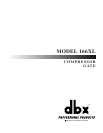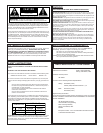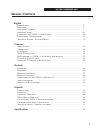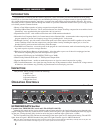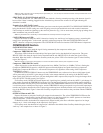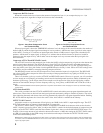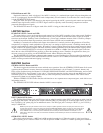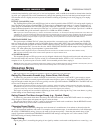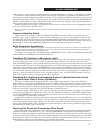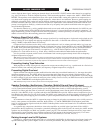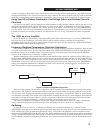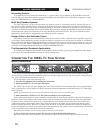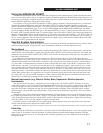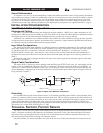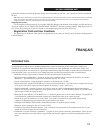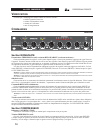
selected when interfacing with “semi-pro” or low level equipment, while a +4dBu level should be selected when interfac-
ing with “pro” equipment. The switch simultaneously changes the operating levels for both the input and output circuits.
Note that the switch is slightly recessed to prevent accidental switching of operating levels while plugging in or unplug-
ging cables.
OUTPUT (BALANCED) Jacks:
The Tip/Ring/Sleeve phone jack and XLR-type jack are wired in parallel; either OUTPUT will send an audio signal to a
load. The phone jack accepts a standard TRS 1/4” phone plug for a balanced output load, or a 2-circuit (Tip/Sleeve) 1/4”
phone plug for an unbalanced load. The XLR-type jack is wired pin 2 HOT(+), pin 3 COLD (-) and pin 1 GROUND. For
proper unbalanced operation, the unused pin (either pin 2 or 3) must be grounded. Nominal output signal level is +4dBu or
-10dBV into 600", and typical maximum output level is +20dBu into 600" (+20dBm).
Note: A given pair of channel output jacks (e.g., Channel 1 XLR OUTPUT and Channel 1 1/4” OUTPUT) are internally connected (TIP = Pin 2, RING = Pin
3, SLEEVE = Pin 1) and can simultaneously deliver the same signal to two separate loads, but if one of the jacks is unbalanced, then the other jack will be
unbalanced. For example, if a 1/4” OUTPUT jack is used with a mono cable, and is therefore unbalanced, the XLR OUTPUT jack will also be unbalanced
(Pin 3 shorted to ground). If using both outputs of a given pair simultaneously, the total parallel load on the output should be 600
"
minimum.
SIDECHAIN INSERT Jack:
This jack accepts a standard TRS 1/4” phone plug and provides a connection to the 166XL detector path. The RING
acts as a Send, carrying a buffered version of the signal present at the 166XL INPUT jack, at an impedance of 2k". The
TIP acts as a Return for equipment to feed the 166XL’s detector circuitry, such as an equalizer for de-essing or frequency-
sensitive gating/compression. You can also drive the 166XL SIDECHAIN INSERT with the output of most equipment, by
using a 1/4” mono phone plug. Input impedance is greater than 10k".
Note: When a cable is plugged into this jack, it automatically breaks the connection from the INPUT circuit to the 166XL’s detection circuitry.
Note: The following Operating Notes section contains several applications for using the sidechain circuit.
AC POWER Receptacle:
This receptacle accepts an IEC-type power cord (as shipped with the unit). Plug the cord into the unit and mains power.
Note that the 166XL does not have a power switch. It is recommended that the 166XL be “On” at all times. Power con-
sumption is low. If you do not plan to use the 166XL for an extended period of time, unplug it.
Warning: Be sure to verify both your actual line voltage and the voltage for which your Model 166XL was wired, as indicated on the rear panel of your unit.
Connection to an inappropriate power source may result in extensive damage which is not covered by the warranty.
OPERATING NOTES
Expander/Gate Applications
Note: Control settings for each application are suggested as a starting point. Adjust them for your requirements.
Gating Dry Percussive Sounds (e.g., Snare Drum, Kick Drum)
To effectively gate percussive sounds with high-level transients, you need to set the 166XL’s gate controls to ensure
that the gate is less sensitive to nearby signals that would cause the gate to open or “false trigger.” Set the RELEASE set-
ting fast enough to enable the gate to close very quickly once the signal falls under the THRESHOLD. The RELEASE can
also be used to shape the envelope of the sound.
Note: Fast gating of sustained low frequency signals can result in “chattering.” Because the 166XL is capable of extremely fast gating, make sure the
RELEASE time is longer than one full cycle of the gated signal’s fundamental frequency. To eliminate any “chattering,” simply adjust the RELEASE time to
a longer time (slower rate). The proper THRESHOLD setting will also minimize false triggering and “chattering.”
These types of settings are most useful for tightening up drum tracks, removing the “ring” from some drums, or gating
out the leakage of one drum through another’s mic.
Gating Sounds That Have Longer Decay (e.g., Cymbal, Piano)
To effectively gate sounds which have more decay after the initial transient, set the RELEASE control slow enough to
allow the gate to remain open and capture the signal’s entire envelope.
The gate can also be used to “dry up” a track or mix that has too much reverb or ambience. Set the RELEASE control
so that the natural decay of the sound is somewhat truncated.
Changing Sound Quality
The 166XL’s gate can effectively change the sonic character of a sound because it can reduce or otherwise alter the
quality of instrumental ambience and reverb. For example, as an instrument stops, its reverberation level will fall through
the 166XL’s THRESHOLD setting. It can now be made to die out more quickly - faster than the natural decay (of the
sound). Experiment with different THRESHOLD and RELEASE settings to change the “tail” of the sound; a FAST
RELEASE setting will nearly eliminate reverb.
Keyed Gating
Keyed gating, that is, controlling the gating of one signal by another, can be used to add dynamics to a sound (e.g., cre-
6
®
PROFESSIONAL PRODUCTS
dbx 166XL COMPRESSOR / GATE



